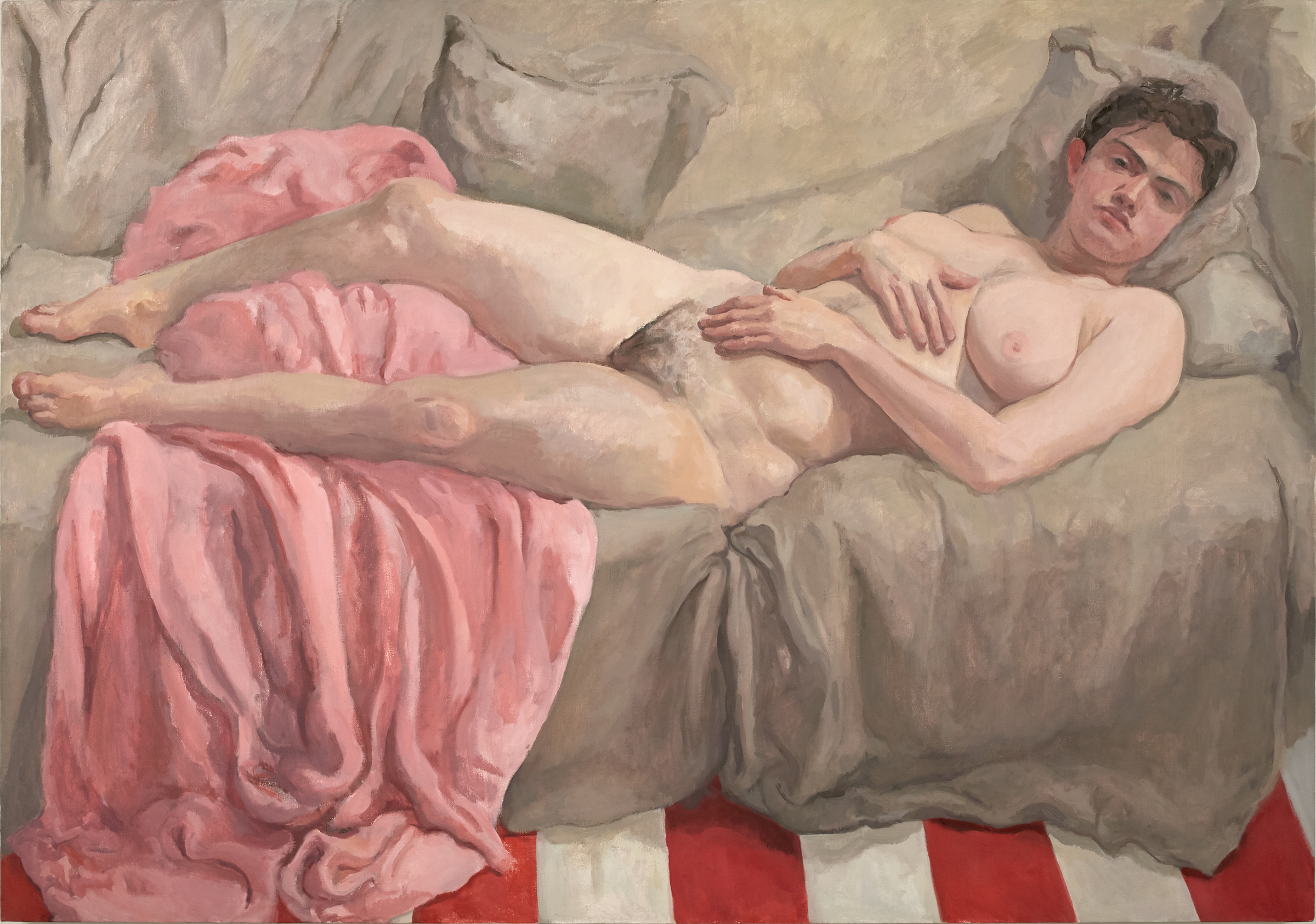This post is also available in:
日本語 (Japanese)
Alix Bailey Reminds Us That Painting Is Light and So Are We
 Photo © by Alix Bailey 2022, “Alex and Pink” 42” x 60”
Photo © by Alix Bailey 2022, “Alex and Pink” 42” x 60”
The gallery indicated that Bailey began bringing only one model into her home during this time in order to limit the possibility for exposure to COVID during the pandemic. I noted that at least one visiter to her exhibition speculated that her work might have suffered from this limitation. However, I believe that Bailey chose to see it as an opportunity. She stated, “One of the rewards of working so closely with the same model over the years is that I come to know them in a way that adds another layer of meaning to the painting. Observing a person over long periods of time, really seeing them is a way of putting them in the light.” As it happened, during this time the model appears to have undergone gender-affirming surgery and, posing nude, allowed Bailey to illustrate the transformation.
But what is even more interesting about these portraits for me — and, I suspect, for Bailey — is not the model’s physical changes but rather Bailey’s ability to evoke the inner light of the model while at the same time capturing the diffuse natural light of her studio and the way that it illuminates everything in the frame.
In these paintings the model looks out at us or past us in a manner neither welcoming nor defensive, physically relaxed and unengaged in any recognizable drama or psychological posing, yet strikingly present. Achieving this type of expression is quite challenging, and when I was facing the paintings, I certainly felt the power of its effect. To my mind, it implies that Bailey and the model achieved such a comfort level with one another that the model was able to drop any desire to hide, seek approval, show off, or otherwise project any attitude or comment on herself. She was able simply to be present, still. And this stillness also manifests in the flat, soft, indirect light of the space.
It is this presence, the model’s life force and Bailey’s deep appreciation for it, that is the real subject of the painting, evident in the way her handling of form and color, light and texture, enables the light of the subject’s being to shine forth. Despite the fact that Bailey’s paintings here are not especially naturalistic nor her colors fully blended, her model’s eyes are nevertheless alive and her body and the fabrics are rendered exquisitely in crucial ways. For instance, in “Alex and Pink,” the viewer can feel the weight of the model’s left hip sinking into the sofa by virtue of the wrinkles her hip makes in the fabric. The arrangement of the pink blanket, bunched together and pushed upward into the light between the model’s legs, and then spilling down the side of the sofa in deep pleats and piling up on the floor, provides Bailey with another dazzling opportunity to depict light and shadow in such a way that the viewer can feel weight and texture and “enter” the substantive reality of the painting.
Bailey renders detail judiciously, only as much as is needed to impart a sense of the inner form and life. One of the model’s hands directs the eye toward her breast and the other hand toward her groin, calling attention to the areas that the model will soon surgically alter. The beautiful sensitivity with which Bailey paints the hands — they look so natural that the viewer can feel them resting on the model’s body, the weight and warm and intimacy of that touch — communicates Bailey’s empathy toward her model and also her desire for her viewers to experience the three dimensionality, the form and substance, of the subject. While the model’s skin is not painted with hyper-realist detail, the shading along the legs helps the viewer to feel the weight of the model’s body, even while the lightness of the model’s thighs and torso bathe the model in light. Thus, the viewer can imagine feeling bathed in light while also feeling grounded.
Elsewhere in Chelsea, there were other galleries showing figurative paintings, but the figures were heavily distorted, being used to communicate political themes, which makes them feel disposable, unimportant in and of themselves. Bailey uses her models, too, but Bailey uses them to convey something innate, fundamental, and inspiring about them. She reminds us that the light for which we all long emanates from within as well as from without. In a way, this is the most radical political statement of all, transcending specific social and political situations while reminding us of our innate ability to illuminate and therefore transform any situation.
The daughter of two painters, Alix grew up in New Haven, Connecticut and in Italy. She studied painting at Bennington College with Pat Adams and Sidney Tillim and received her MFA from Indiana University in 1994. She has shown her work in New York, Connecticut, and Italy and is currently a member of The Painting Center. She lives and paints in New York City and Taghkanic, NY with her two daughters. She has had solo shows in New York City and in Hudson, NY, and her paintings have been featured in shows around the country and in Italy. Her work has been reviewed in Hyperallergic, The Hudson Review and Tussle magazine.

0 Comments